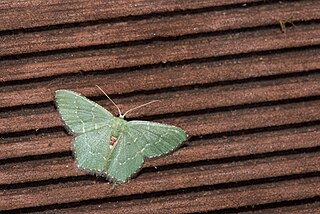
The Legendary Pink Dots are an Anglo-Dutch rock band formed in London in August 1980. In 1984, the band moved to Amsterdam, playing with rotating musicians and having, as core members, singer/songwriter/keyboardist Edward Ka-Spel and keyboardist Phil Knight. In 2022, founding member and synthesist Philip Knight retired from touring, and Randall Frazier joined the band on synths, samples and electronics.

The band-winged nightjar or greater band-winged nightjar is a species of nightjar in the family Caprimulgidae. It is widespread in South America, where it is found in the Andes, Venezuelan Coastal Range, Santa Marta Mountains, Tepuis, most of Chile, Argentina, Paraguay, Uruguay, and eastern Brazil. It occurs in a wide range of habitats, from the edge of humid montane forests to shrubby semi-deserts and urban rooftops.

Ecliptopera silaceata, the small phoenix, is a moth of the family Geometridae. The species was first described by Michael Denis and Ignaz Schiffermüller in 1775.

Pink Dot is a quick delivery prepared-to-order grocery store based on the Sunset Strip in West Hollywood, California. The store has appeared in several movies and television shows, including HBO's Entourage.

Pink Dot SG, known endonymously as Pink Dot, is a pride event that has occurred annually since 2009 in support of the LGBT community in Singapore. Attendees of Pink Dot events gather to form a "pink dot" to show support for inclusiveness, diversity and the freedom to love in the country. Pink Dot events typically include concert performances and booths sponsored by organizations that support the LGBT community and cause in addition to the event's name-brand formation.

Actinotia polyodon, the purple cloud, is a moth of the family Noctuidae. It is found in much of the Palearctic realm, from Europe to Russia and Japan.

Acasis viretata, the yellow-barred brindle, is a moth of the family Geometridae. The species was first described by Jacob Hübner in 1799. It is found from most of Europe and across the Palearctic to Korea. In northern India it is represented by Acacis viretata himalayica. It is also present in North America. It occurs in many different habitats, including deciduous and mixed forests, rocky slopes and valleys, as well as bushy meadows, bogs and taiga areas. In the Alps it can still be found at an altitude of 1700 meters

Agonopterix ciliella is a moth of the family Depressariidae. It is found in most of Europe, except the Iberian Peninsula, most of the Balkan Peninsula and the Benelux. It is also found in North America.
Inga languida is a moth in the family Oecophoridae. It was described by Edward Meyrick in 1911. It is found in Venezuela.
Garrha rufa is a moth in the family Oecophoridae. It was described by Edward Meyrick in 1883. It is found in Australia, where it has been recorded from New South Wales.
Hierangela doxanthes is a moth in the family Gelechiidae. It was described by Edward Meyrick in 1929. It is found on New Guinea.
Thiotricha rhodomicta is a moth of the family Gelechiidae. It was described by Edward Meyrick in 1918. It is found in Assam, India.
Thiotricha chrysantha is a moth of the family Gelechiidae. It was described by Edward Meyrick in 1908. It is found in Assam, India.
Kertomesis rhodota is a moth in the family Autostichidae. It was described by Edward Meyrick in 1911. It is found in India.
Kertomesis stesichora is a moth in the family Autostichidae. It was described by Edward Meyrick in 1911. It is found in India.
Doina edmondsii is a moth in the family Depressariidae. It was described by Arthur Gardiner Butler in 1883. It is found in Chile.
Gonionota oligarcha is a moth in the family Depressariidae. It was described by Edward Meyrick in 1913. It is found in Peru.

Hemithea marina is a moth of the family Geometridae first described by Arthur Gardiner Butler in 1878. It is found in the Indian subregion, Sri Lanka to Japan, Sundaland, Taiwan, Sulawesi and Seram.

Lathicrossa prophetica is a species of moth of the family Oecophoridae. It is endemic to New Zealand and has been found in both the North and South Islands. This species inhabits sub-alpine native forest and adults are on the wing in January. It is classified as "Data Deficient" by the Department of Conservation.

Coenonympha vaucheri, or Vaucher's heath, is a butterfly that belongs to the family Nymphalidae and is endemic to Morocco.










